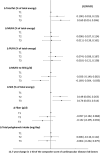Incremental monounsaturated to saturated fat ratio and fibre consumption is associated with a reduction in a composite score of modifiable cardiovascular risk factors: Prospective results from the Moli-sani study
- PMID: 35906332
- PMCID: PMC9336117
- DOI: 10.1038/s41430-022-01185-4
Incremental monounsaturated to saturated fat ratio and fibre consumption is associated with a reduction in a composite score of modifiable cardiovascular risk factors: Prospective results from the Moli-sani study
Abstract
Background/objectives: Unsaturated fats, fibre-rich foods and polyphenols are distinctive features of a traditional Mediterranean diet and have pleiotropic properties possibly contributing to reduce the long-term risk of non-communicable diseases and mortality associated with this diet. We aimed to evaluate whether changes over time in dietary fats, fibre and polyphenols consumption are associated with modifications in cardiovascular disease (CVD) risk factors.
Methods: The analytic sample consists of a sub-cohort of 2023 men and women enrolled in the Moli-sani Study (n = 24,325). Dietary and health data were obtained both at baseline (2005-2010) and at re-examination (2017-2020). The exposures were changes in dietary fats, fibre and polyphenols consumption measured after 12.7 years (median), and the outcome was change in a composite score including 13 modifiable CVD risk factors (e.g., blood lipids, C-reactive protein), measured both at enrolment and after the 12.7 years period.
Results: In multivariable-adjusted analysis including lifestyles, sociodemographic and clinical factors, an incremental intake of the ratio of monounsaturated to saturated fats or of fibre was associated with a reduction in the composite score of CVD risk factors (β = -0.086; 95%CI -0.150, -0.021 and β = -0.051; 95%CI -0.091, -0.012, respectively). Change in polyphenol intake was not associated with a substantial variation in the CVD risk score (p = 0.15).
Conclusions: An incremental consumption over time of monounsaturated versus saturated fats and of fibre was associated with an improvement in modifiable CVD risk factors as reflected by a composite score.
© 2022. The Author(s), under exclusive licence to Springer Nature Limited.
Conflict of interest statement
The authors declare no competing interests.
Figures

Similar articles
-
Increased Adherence to a Mediterranean Diet Is Associated With Reduced Low-Grade Inflammation after a 12.7-Year Period: Results From the Moli-sani Study.J Acad Nutr Diet. 2023 May;123(5):783-795.e7. doi: 10.1016/j.jand.2022.12.005. Epub 2022 Dec 19. J Acad Nutr Diet. 2023. PMID: 36549563
-
Dietary fat intake and risk of cardiovascular disease and all-cause mortality in a population at high risk of cardiovascular disease.Am J Clin Nutr. 2015 Dec;102(6):1563-73. doi: 10.3945/ajcn.115.116046. Epub 2015 Nov 11. Am J Clin Nutr. 2015. PMID: 26561617 Clinical Trial.
-
Mediterranean diet and other dietary patterns in association with biological aging in the Moli-sani Study cohort.Clin Nutr. 2022 May;41(5):1025-1033. doi: 10.1016/j.clnu.2022.02.023. Epub 2022 Mar 8. Clin Nutr. 2022. PMID: 35390726
-
The role of dietary fats for preventing cardiovascular disease. A review.Rocz Panstw Zakl Hig. 2013;64(4):263-9. Rocz Panstw Zakl Hig. 2013. PMID: 24693710 Review.
-
Dietary Fats and Cardiovascular Disease: A Presidential Advisory From the American Heart Association.Circulation. 2017 Jul 18;136(3):e1-e23. doi: 10.1161/CIR.0000000000000510. Epub 2017 Jun 15. Circulation. 2017. PMID: 28620111 Review.
Cited by
-
The Impact of the Mediterranean Diet on Telomere Biology: Implications for Disease Management-A Narrative Review.Nutrients. 2024 Aug 2;16(15):2525. doi: 10.3390/nu16152525. Nutrients. 2024. PMID: 39125404 Free PMC article. Review.
-
Normal hearing function genetics: have you heard all about it? An integrated approach of genome-wide association studies and transcriptome-wide association studies in three Italian cohorts.Front Genet. 2025 May 19;16:1522338. doi: 10.3389/fgene.2025.1522338. eCollection 2025. Front Genet. 2025. PMID: 40458558 Free PMC article.
-
Are Methylation Patterns in the KALRN Gene Associated with Cognitive and Depressive Symptoms? Findings from the Moli-sani Cohort.Int J Mol Sci. 2024 Sep 25;25(19):10317. doi: 10.3390/ijms251910317. Int J Mol Sci. 2024. PMID: 39408648 Free PMC article.
-
Comparison of Metabolic Response to Colonic Fermentation in Lean Youth vs Youth With Obesity.JAMA Netw Open. 2023 May 1;6(5):e2312530. doi: 10.1001/jamanetworkopen.2023.12530. JAMA Netw Open. 2023. PMID: 37159195 Free PMC article.
References
-
- Dietary Guidelines Advisory Committee. 2020. Scientific Report of the 2020 Dietary Guidelines Advisory Committee: Advisory Report to the Secretary of Agriculture and the Secretary of Health and Human Services. U.S. Department of Agriculture, Agricultural Research Service, Washington, DC.
Publication types
MeSH terms
Substances
LinkOut - more resources
Full Text Sources
Research Materials

